A key to a healthy lifestyle change and a diet is consistency and determination. The human body needs and likes consistency. Mindful eating or eating consciously is a technique that helps you gain control and regulate your eating habits. It has been shown to cause weight loss, reduce binge eating, and help your overall health. Unconscious eating patterns are the most common theme and struggle among clients. Usually weigh gain is accidental; the outcome of a busy life, emotional stress, mental stress, or even mental weakness. All of these can lead to unconscious eating habits and accidental weight gain.
Unconscious eating can be identified through physical, emotional, or mental symptoms and causes. Physical symptoms of unconscious eating are weight gain an physical causes could be mindless eating, an injury, or an unwanted lifestyle change. Emotional issues can drive unconscious eating and form a reliance on food as a coping mechanism. Mental causes are noticeable when you find yourself justifying poor eating decisions by statements such as “I don’t want it to go to waste…” or “it was a rough day, I deserve this…”. It is important to notice and correct these habits when trying to maintain consistency to improve a healthy lifestyle.
How often do you find yourself in the kitchen breaking into you stash of junk food that you bought with the intentions of saving it or eating it sparingly? You typically eat a couple pieces and then a couple minutes or hours later you find yourself back inside the kitchen picking through the same stash. How about eating the appetizers such as ships and salsa when going out to eat? After about 15 minutes you look down and notice the ENTIRE basket of chips are gone and you’re in need of more. These mindless habits are hurtful to the body and mind.
Not all people are aware of the consequences of their eating habits and choices. The belief that a calorie is a calorie and they’re all the same is a common myth when watching caloric intake. Different calories sources have different effects on hunger, hormones, metabolic rates, and expenditure. Therefore strictly counting calories is not necessary to lose weight but instead changing the source of the calories! It is important to be aware of eating decisions and the nutrients that are being received from them!
“Mindful eating is about awareness. When you eat mindfully you slow down, pay attention to the food you’re eating, and enjoy every bite” -Susan Albers
A good way to practice mindful eating is to be aware of your body, how it feels, what it needs, and your actions. Since people eat for reasons other than physical hunger the first question to practice asking yourself is “why do I eat?”
Why do I eat? This helps to realize the reasons other than physical hunger that you turn to food; it can include stress, fatigue, social events, and other reasons.
When do I eat? This can depend on physical hunger but also can be dependent on the clock/ time of the day, a busy schedule, or emotions.
What do I eat? This examines the reasons as to why you choose the foods you choose. It can be taste, nutrition, comfort, or availability.
How do I eat? This indicates if you eat quickly, rushed, secretly, or mindful.
Where do I invest my energy? Eating different types of foods may cause you to feel sluggish and cause you to drag behind. Eating the right types of food will help your energy levels and lead to more productive days.
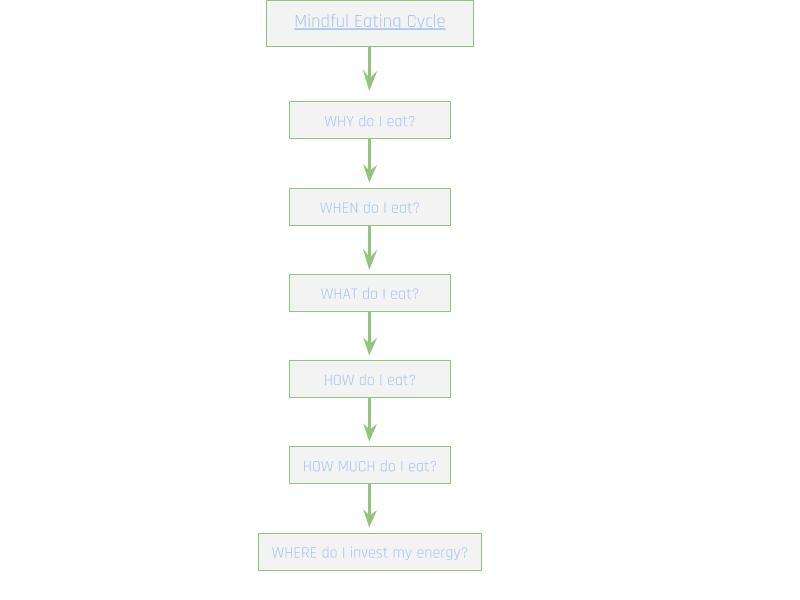
This cycle is implemented in the Nuviva lifestyle program and it helps to promote wellness throughout your lifestyle. It is important for us, not only to advise clients on the food that they eat but also to break the mindset and lifestyle that got them in the position that they are unhappy with. With this practice and mindset it makes this process easier, more pleasant, and more permanent for clients This fosters a healthful relationship with food and pushes the clients to become more aware of the nourishment available through the process of food preparation and consumption. The phases throughout the program not only work to reduce carbohydrates, sugars, and caloric intake but also to break the habit of unconscious eating and to form mindful, conscious eating. Conquering this also is detrimental to the success of starting a new lifestyle.
Glutathione, also known as gamma-glutamylcysteinylglycine (GSH), is a tripeptide. A tripeptide is a peptide consisting of three amino acids (cysteine, glycine, and glutamic acid). Peptides are extremely diverse and play a large amount of important roles throughout the body. Peptides make up proteins, some act as hormones; act as structural components for muscles and much more!
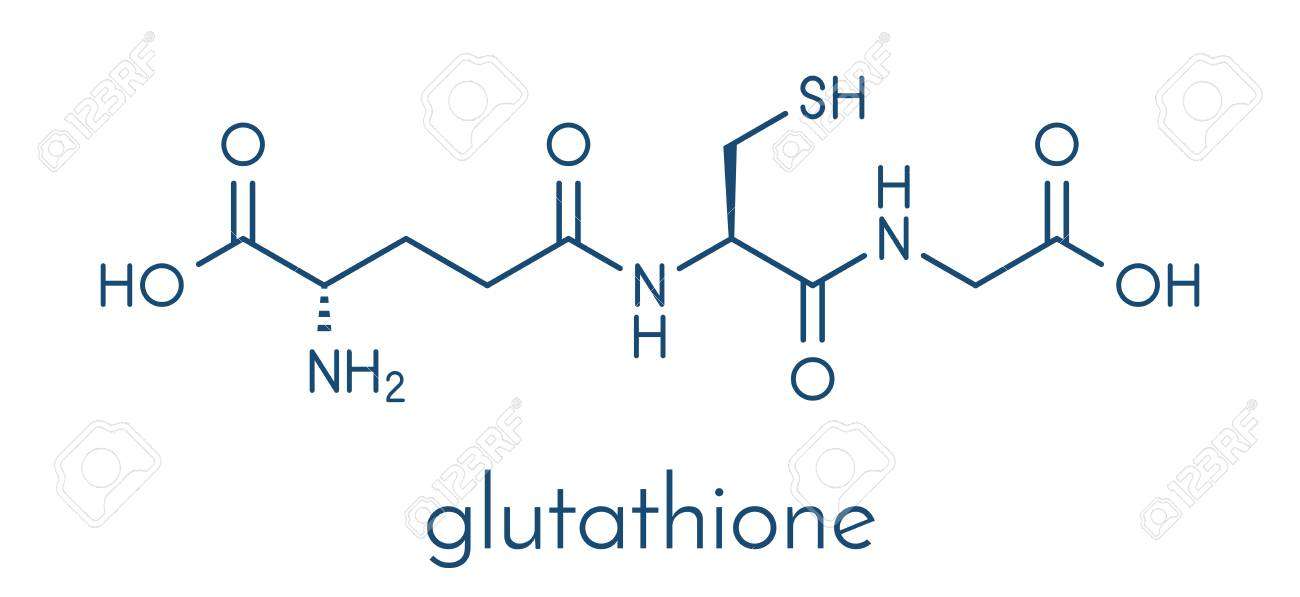
Glutathione is a powerful and much needed tripeptide for the body. It is an antioxidant, a detoxifier that plays a key role in immune system. The largest concentrations of glutathione are found in the liver. It is considered some of the body’s first line of defense against oxidative stress. Oxidative stress and damage is proven to be a large contributor to aging and deterioration in physiological function. Oxidation takes place as our bodies process the oxygen that we breathe and our cells produce energy from it. It happens during a number of bodily functions. During this process, free radicals are produces; free radicals interact with molecules inside of our cells. When the amount of free radicals produced overpowers the repair process then oxidative stress is taking place. Antioxidants are what help to keep the free radicals from over powering the repair system within our cells. The discovery of glutathione’s defense against oxidative stress caused researchers to investigate and discover that there is direct correlation between ageing and decreased intracellular concentrations of glutathione.
Glutathione is also a defense against a number of toxins such as heavy metals, benzenes, and pesticides. These toxins are constantly attacking our cells and enzymes. The environment is loaded with toxic metals and glutathione helps with the removal of any toxins within the body. It also reactivates the antioxidants vitamin C and E after they have been oxidized.
Glutathione has an extremely large range of benefits and studies are still being conducted to find even more from this powerhouse. It reverses damage from free radicals, recharges other depleted antioxidants, supports and maintains the immune system, supports protein structures, and removes heavy metals like mercury circulating through the liver. Overall this is an extremely important and over looked product! It is beneficial in SO many ways not only when living a healthy lifestyle but also just attempting to maintain health. It is well worth trying!
One largely overlooked component to a new healthy lifestyle is water intake. Staying hydrated and drinking enough water is key for many factors from digestion to muscle function. Every single cell within the human body needs water to function properly. Nuviva recommends 8 (8oz.) glasses of water each day in order to insure that everyone is getting enough. This amount can differ based on a person’s lifestyle and needs so if you feel like you need more water, drink it!
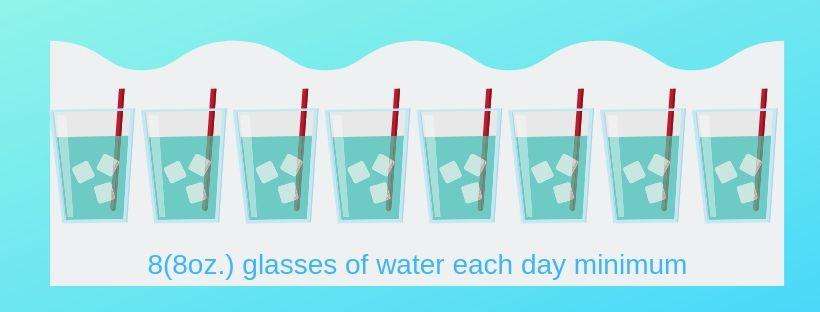
Many studies show the direct correlation between increased water consumption and weight loss. One study published in the Journal of Natural Science found that after 8 weeks the increase in water intake made a difference by lowering body weight, body mass index, body fat, and appetite. This study established and proved the role of drinking water when trying to lose weight and also stabilizing your appetite.
Water is a natural appetite suppressant. It helps to take up space within your stomach and makes you feel full. One trick is when you feel like you’re aimlessly snacking or over controllably hungry, drink a glass of water instead of reaching for a snack. Sometimes our body and brains confuse hunger with thirst.
Water also increases calorie burning. Have you ever heard of drinking body temperature water? Or the theory, drinking hot water makes you hydrate faster? This is true. When you ingest cold or even room temperature water, your body has to work to warm the water to body temperature. This increases your resting energy use because your body is burning calories to warm the water for digestion.
Water also helps remove waste from the body. It also helps your body recover from digestive problems. It helps the kidneys when filtering out toxins and waste. When you are dehydrated your kidneys retain fluid and can cause bloating or discomfort. Dehydration can also lead to constipation as well. Waste build up leads to the dreaded bloated feeling along with extra inches, swollen, and fatigue. In order for the body to properly cycle out waste and retain essential nutrients you must stay hydrated!
If you drink water, you’re less likely to be drinking something else. Drinking water helps to reduce the overall liquid calorie intake by replacing soda with water. The high sugar and caffeinated drinks actually dehydrate you! So replace them with water and magic can happen!
Water is absolutely necessary to burn fat! Without getting extremely scientific-water helps your body metabolize and burn fat through a process called lipolysis. The first step of this process requires a molecule from the water to interact with a fat molecule. This is an extremely important human body process.
Water also helps with workouts. We all knew this one! It helps muscles, connective tissues, and joints to move properly. It also helps the lungs, heart, brain, and other organs to work effectively with maximum activity. Water also helps to fight and decrease muscle cramps and fatigue.
With all of this information given about how magical, important, and beneficial water can be it’s surprising to discover how many people don’t drink the recommended amount of it! The image below gives some tips to help increase water intake in easier ways!
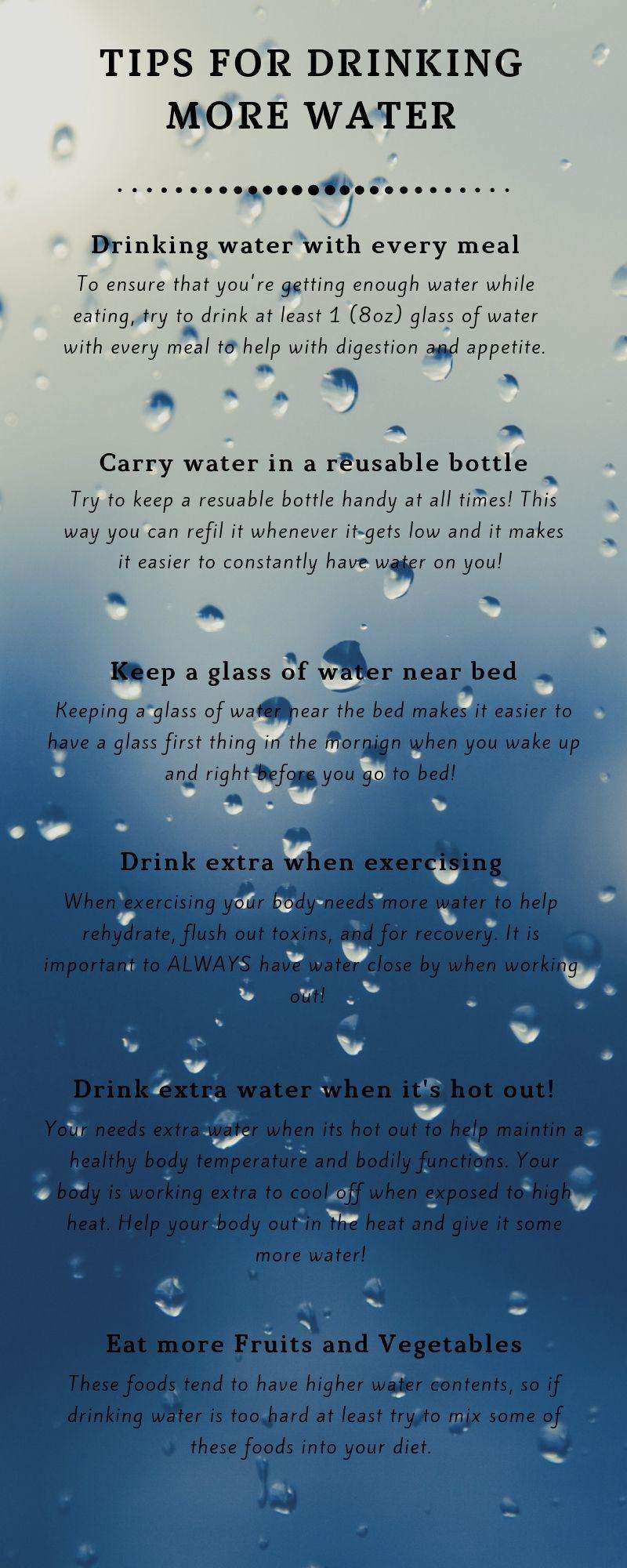
If you type “Weight Loss” into your search bar you will be bombarded with fad diets, magic pills, cleanses, and so many other tips, tricks, or scams. How can you tell what is the truth? How can you tell what will work? It’s frustrating to have to filter through these results. The trial and error that can come from each technique can make it seem impossible to lose weight.
Here are some myths about weight loss to help you avoid scams and to find things that are more likely to be beneficial than harmful!
Juice Cleanses are known as a way to quickly lose weight and to detox. BUT even though there is a calorie reduction, there is also a lot of liquid sugar. This can spike the blood sugar and cause weight gain. Juice cleanses also starves your body of some necessary nutrients for daily functions. This deprivation is never a good idea. Long-term damage such as slowing down your metabolism can be a side effect of this “cleanse”. Your body can go into conservation mode because it doesn’t know when it’s going to receive its next meal. Detox your system by eating clean for a little while instead!
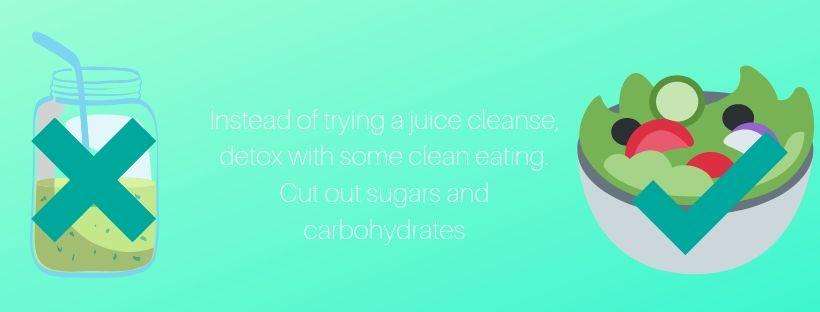
Too low of a calorie cut for too long can have the opposite effect. Your body will be deprived of some valuable calories and macronutrients. Under eating is just as dangerous as over-eating. This can lead to nutritional deficiencies. This can also cause your body to burn and lose muscle mass while slowing down your metabolic rate. Both are not beneficial for long-term weight loss and your overall health.
Exercising to lose weight and you can still eat what you want. As much as we would love for this to be the truth, sadly it isn’t. Exercise does have many beneficial reasons behind it but unfortunately; weight loss is not one of them. For more information and a better explanation, refer back to our post Exercise and Weight loss.
You can sweat out fat. No, you actually cannot. Turning to a steam room or sauna might cause you to drop a few pounds but it’s only temporary water weight that you’re losing. So if you have an upcoming event the next day, maybe this could be a quick solution to drop some extra pounds. Sadly, a salty or processed meal or a glass of wine will make those pounds come back again.
Try avoiding these suggestions when looking for weight loss tips. Simply clean eating and correct portion sizes can make a dramatic change without having to try fad diets, depriving your body, or gross juice cleanses.
Added sugars may be the single unhealthiest thing in the modern diet and can be hidden in many ways by food processing companies. Leading added sugar sources are sugar-sweetened beverages, grain-based desserts (cakes and cookies), candy, and dairy desserts like ice cream. These common treats store many different types of hidden sugars and can be harmful when overly consumed!
Sugar is added to food while its being processed to enhance flavor, texture, and shelf life to increase profits and sales. Added sugar is usually in the form of glucose, fructose, or sucrose. Daily added sugar limit for men is no more than 9 teaspoons while women cannot consume more than 6 teaspoons. Sadly, manufacturers often hide the total amount of sugar by listing it under several different names on the nutrition facts. It’s important to be aware of how much sugar you intake daily because our bodies don’t need sugar to function properly.
Different types of added sugars have different effects on the body. Almost every cell in the body can metabolize glucose because it is a sugar humans use to make energy, while fructose is metabolized almost completely in the liver. Studies have been conducted to prove that high fructose consumption can be linked to insulin resistance, metabolic syndrome, fatty liver, and type 2 diabetes.
The most common type of sugar is sucrose or table sugar. It is the sugar that is extracted from sugar cane or sugar beets and is 50% glucose and 50% fructose. It is found in many common household foods such as fruit juices, processed meat. Breakfast cereals, condiments, cookies, and more.
High-Fructose corn syrup is a sweetener that is found in many foods throughout the US. It is produced from cornstarch and consists of fructose and glucose. Two common types are HFCS55 and HFCS90. The numbers indicate how much fructose each form contains. HFCS55 contains 55% fructose and 45% glucose. HFCS90 contains 90% fructose.
Agave Nectar or agave syrup is another popular sweetener produced from the agave plant. It doesn’t spike blood sugar levels in comparison to other sweeteners so it is referred to as a ‘healthier’ alternative. Agave nectar contains about 70-90% fructose and 10-30% glucose meaning it is not a ‘healthier’ alternative since its high in fructose. It is used in many health foods such as yogurts and fruit bars.
This does not mean that ALL sugar is terrible or that you need to avoid eating anything with sugar in it. Natural sugars are found in fruits and vegetables and when properly portioned, they are not harmful to a healthy diet. They contain small amounts of sugar but also contain fiber, nutrients, and other beneficial components. The negative health effects spoken about high sugar consumption is due to the massive amount of added sugar that is present in the US modern diet. About 75% of all foods and beverages contain added sugar, hidden in the large array of forms provided.
The best way to avoid added sugars it to eat whole, clean, and unprocessed foods. If package food is a necessity in your lifestyle then be mindful of what sugars can be hiding inside it. Check the packaging for any of the listed sugars provided in this article. Also check that portions of sugar and be mindful to your daily intake!
This chart provides all different types of added sugars to be aware of when buying processed foods.
Summer time has come around and all of a sudden eating healthy has become more difficult. Beach trips, vacations, and summer holidays seem to bring temptation and make it more difficult to stay on track. This article will provide you with some tips to help yourself out, especially through this holiday week!

While on vacation try to engage in physical activity! This may help offset any overconsumption that could occur. If you’re at the beach take a stroll in the sand or swim in the ocean. While staying at a hotel take some laps in the pool or walk around the town you’re visiting. When sightseeing try to take the more physically interactive route; instead of taking a bus or motor tour try a walking tour. See if there are any physical activities offered where you are staying- there could be kayaking adventures, hiking adventures, or even white water rafting adventures. All of these are healthier alternatives!
One important thing to remember during the summer and on any vacation is traveling and heat can dehydrate you very easily. Drink A LOT of water while participating in different physical activities or even just laying out on the beach! Pack water in your backpack, hotel mini-fridge, and your car, anywhere that you think you’ll need it! The easier it is to access the less likely you are to become dehydrated. You need to keep all your systems going while on vacation and don’t deprive your body of what it needs!
During beach trips, vacations, and holidays it can be difficult to prepare for things. Preparation is key to following a healthy lifestyle during times like these. Pack a cooler for your car or beach trip. Fill it with healthy snacks and set a timer on your phone to make sure you’re eating every 2-3 hours! Usually when traveling or participating in summer vacations people tend to forget to eat and then end up starving and overeating at the end of the day. REMEMBER to eat throughout the day to avoid overeating high carb foods at night!
A lot of people like to celebrate by eating out. This seems to be hard for most people who are trying to avoid the temptation of bad foods and oversized portions. When eating out try not to think of it as a special treat. Americans use to believe that going to a restaurant was a rare occurrence but now most families eat out for no reason at all! If you can convince yourself that this occasion isn’t something that you need to splurge on then the temptation will seem weaker! Plan ahead and take a peak at the menu before you even arrive at the restaurant- you have an idea of what you can and can’t have. To avoid the appetizers by ask for a small side salad, this way you have something in front of you while everyone is eating the bread rolls! The last tip for staying on track is avoiding the larger portion sized meals; try to order the half portions. Most restaurants offer smaller plates-these are the best options to help ensure you are not over eating. If the restaurant does not offer a smaller plate ask someone if they would like to split something with you OR when you receive your food, ask for a take home box and automatically place half of it inside to shut it. The last option helps keep the extra food out of sight, most people have a unconscious habit of eating whatever is in front of them; this will help avoid that tendency.
A popular topic of conversation when discussing weight loss or developing a healthy lifestyle is mostly what foods to avoid and what foods to eat. One commonly misunderstood topic is; if it’s good for you, you can eat it whenever and as much as you want. This is incorrect. Portion control is so important to weight loss, maintaining a properly functioning digestive system, and a healthy lifestyle. Eating the right portions is just as important as eating the right foods.
There are major benefits of portion control besides weight loss. Improved digestion occurs from the lack of overloading your system. With proper portions you avoid indigestion, cramps, discomfort, and bloating. Overeating can lead to a blood sugar imbalance because of the large intake of glucose. Overloading your body with glucose can lead to insulin resistance. Money savings is often tied to proper portion control. When you eat the proper sizes-you do not have to buy as much groceries because you are not overeating. Your groceries will last longer!
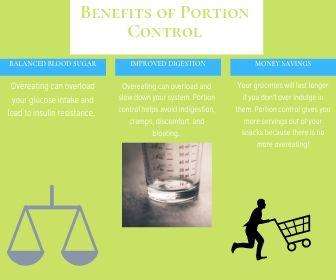
People tend to have a hard time recognizing proper portions and serving sizes. This is a direct effect from societies super sized meals that have doubled or tripled over the past 20 years. This is also directly linked to increased obesity rates. This can be slightly avoided if you pay attention to the serving sizes on the nutrition label. Portion and serving sizes are often used in replacement of each other. Even though they are correspondently related there is a difference between the two.
Portion size: is the amount of food you choose to eat in one sitting. This may be more or less than a serving size.
Serving size: is a standardized amount of food. It is often used to quantify recommended amounts and found on the Nutrition Facts label.
Referencing serving sizes helps with maintaining portion control. You may eat an 8 oz. sirloin steak at a restaurant, this is your portion size, but the actual serving size of beef is 3 ounces
There are ways to overcome portion distortion.
Practice measuring out the correct portion sizes when prepping meals. Measuring foods at home help you realize proper portions quicker to make better decisions when you have to.
Read the Nutrition Facts label to help you identify the proper serving size.
Instead of eating straight out of the bag or box eat off of a plate or small bowl. It’s harder to eat more if you only put the actual serving size in front of you.
Avoid mindless eating in order to make sure you are aware of how much you intake.
Share meals when dining out. Restaurants often serve oversized portions so sharing your food with someone else will help keep the portions more reasonable. If this isn’t an option- ask the server to box half of your meal before bringing it to you to avoid temptation.
Use smaller plates when eating. It seems that as portion sizes have increased so have the plates. A smaller plate will look fuller and trick your brain into thinking you’re eating more food.
Lastly, prepping meals for the week ensures that you have proper portions ready to go!
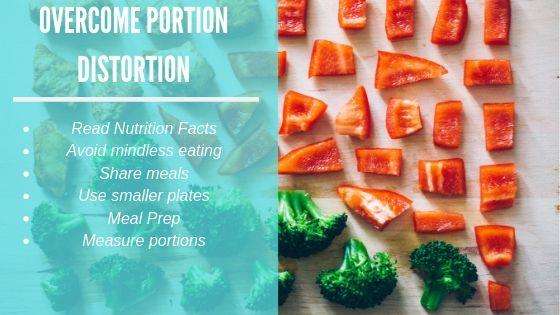
So this week, I am approaching this article with the intent of it being a more useful article for everyday or every week. This article will be a good reference for you when you are grocery shopping or organizing your groceries when you get back home. People tend to struggle when looking for items at the grocery store that add a little variety to their diet. This will provide you with variety and hopefully inspire your future trips to the grocery store. Another tip is to change up the spices or seasoning that you use while cooking. You can continue to buy the same exact things but with different seasoning it makes a larger variety in your meals. I try to have Mexican inspired meals one night a week. I also like to add in low sugar balsamic vinegar on top of my vegetables for a different flavor or kick!
Some options that may help prepare for the week are stocking up on backups. I like to use frozen vegetables or meals as a back up during the week. I always have a couple sides and a couple entrees available in my freezer. They’re usually used on late night, or low energy nights. They’re a great stress reliever when you realize you have nothing planned or prepared for dinner! I typically grab frozen cauliflower-there are a lot of different brands that offer riced, mashed, and steamed cauliflower. These are easy because they’re already prepared in so many different varieties.
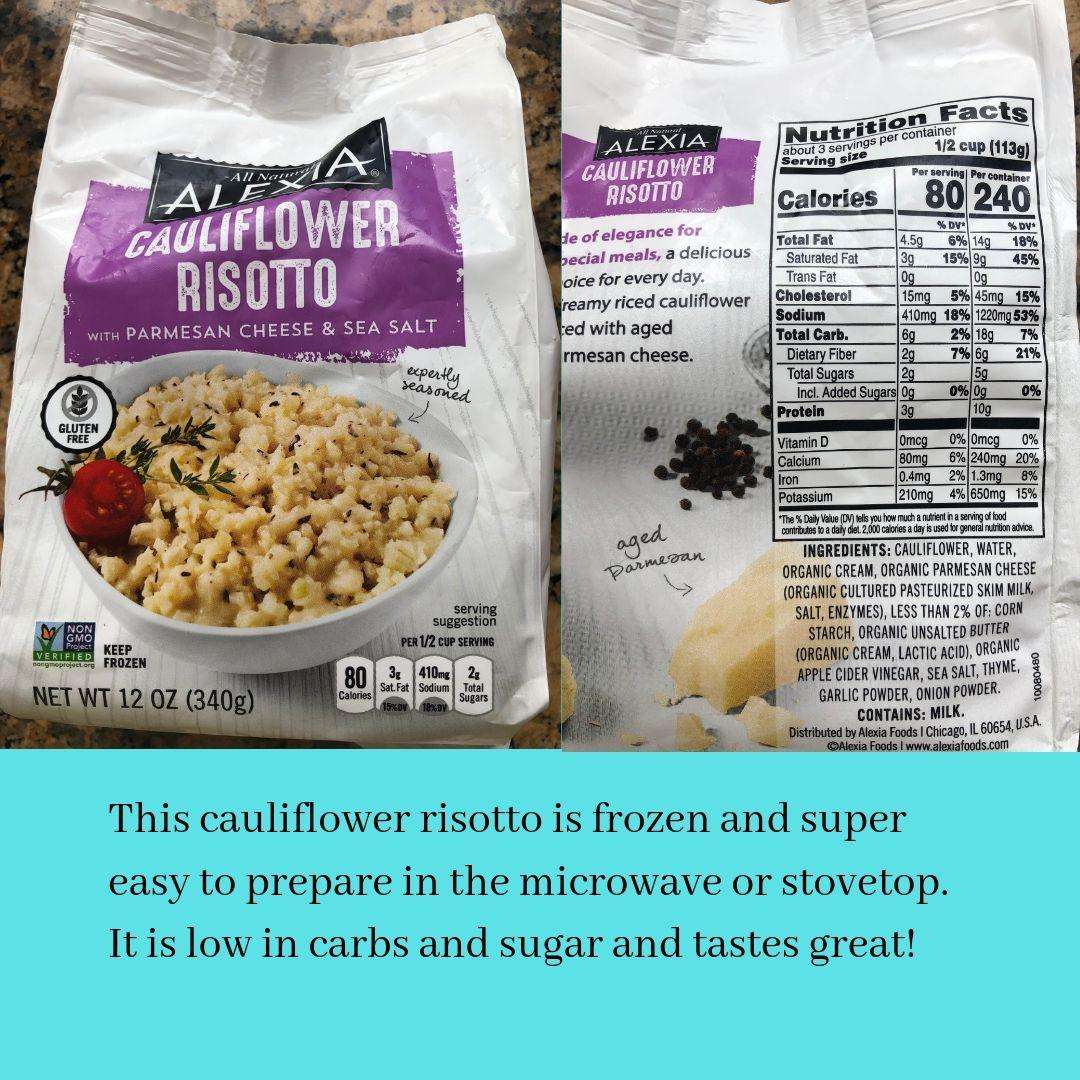
A large portion of my grocery shopping consists of finding fresh produce. I LOVE to stock up on vegetables for the week. Vegetables are a great way to add variety to your diet. There are so many different ways to cook them, season them, and serve them! I typically tend grab peppers, onions, asparagus, brussel sprouts, broccoli, or cauliflower. I like to grab the premade bags of vegetables. My go to is the pre-riced cauliflower bags! You can cook it on the stovetop or in the oven and add whatever seasonings you want to it. There is recipes for buffalo cauliflower to stir-fry cauliflower rice
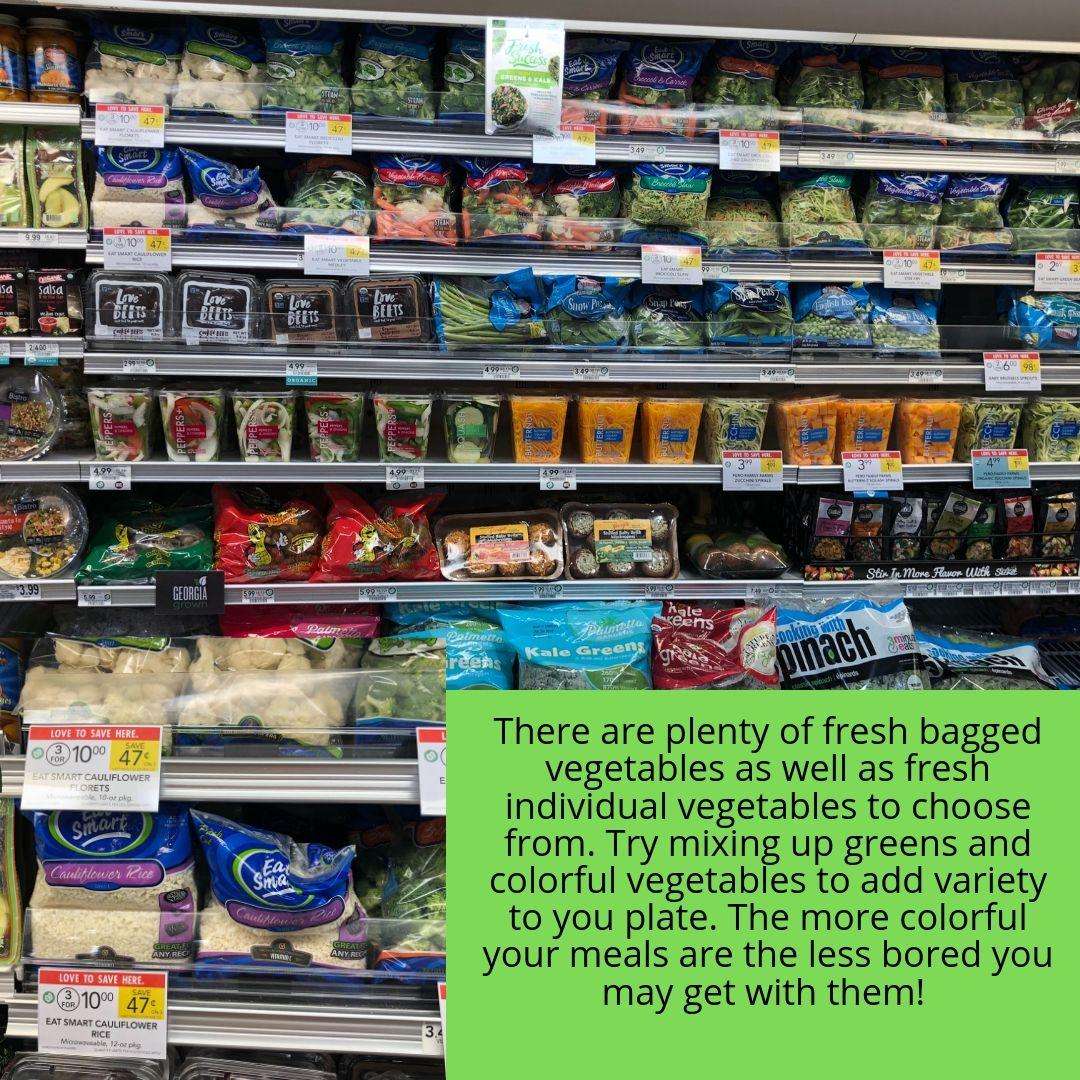
Another way to add variety to your diet is through your snacks. Try to mix it up throughout the week so you don’t get sick of one specific snack! I love fruit and there are so many different types of fruit to mix it up with!I usually grab one type of berry (strawberries, blackberries, blueberries, etc.). I also like to grab apples OR small oranges and peaches. I also like to grab lite cool whip to keep in my freezer for a late night snack. Atkins brand sells snacks that you can use to substitute when you are having a sweet craving. I prefer the chocolate mousse bars but there are other options as well! You can also grab snack bars, nuts, and so much more!
The most important part is my protein sources. I typically like to have frozen meals just incase but I usually like to eat chicken or fish. I eat steak rarely and don’t often purchase it from the grocery store. I try to buy ground chicken or turkey to use for prep meals or with my salads. I also like to buy thinly sliced chicken breasts, chicken thighs, or chicken legs. If I know a busy week is ahead I like to buy a rotisserie chicken to have in the fridge just to heat up quickly. It’s a little fresher than frozen meals, so it’s a good alternative.
Overall, try to mix up your grocery shopping. Look for different vegetables each week. I typically base my decisions off of which ones look the freshest, or which taste I am craving. Look for different snacks each week; try to mix up the type of fruit, nuts, or snack bars that you buy. You can also add sweet snacks if you are having sweeter cravings! Most importantly mix up your proteins, it doesn’t necessarily have to be a different source but even different cuts can add a variety. Ground chicken can be cooked with different seasonings than chicken breasts or chicken thighs. If you are not comfortable with changing you grocery list, mix up you seasonings and how you cook your food!
Hopefully this will help add some new excitement to your diet. The more excited you are about your food and what you eat, the better outlook you have about this lifestyle!
Last week we shared some ideas to take along with you while you grocery shopped. This week will be how to meal prep with some items from the grocery store. Ground Turkey taco bowls are one of my favorite meal preps. It is extremely easy, quick, yummy, and filling. I usually get three meals out of this meal prep and I use them for lunch or dinner!
Print out this photo to take shopping with you!
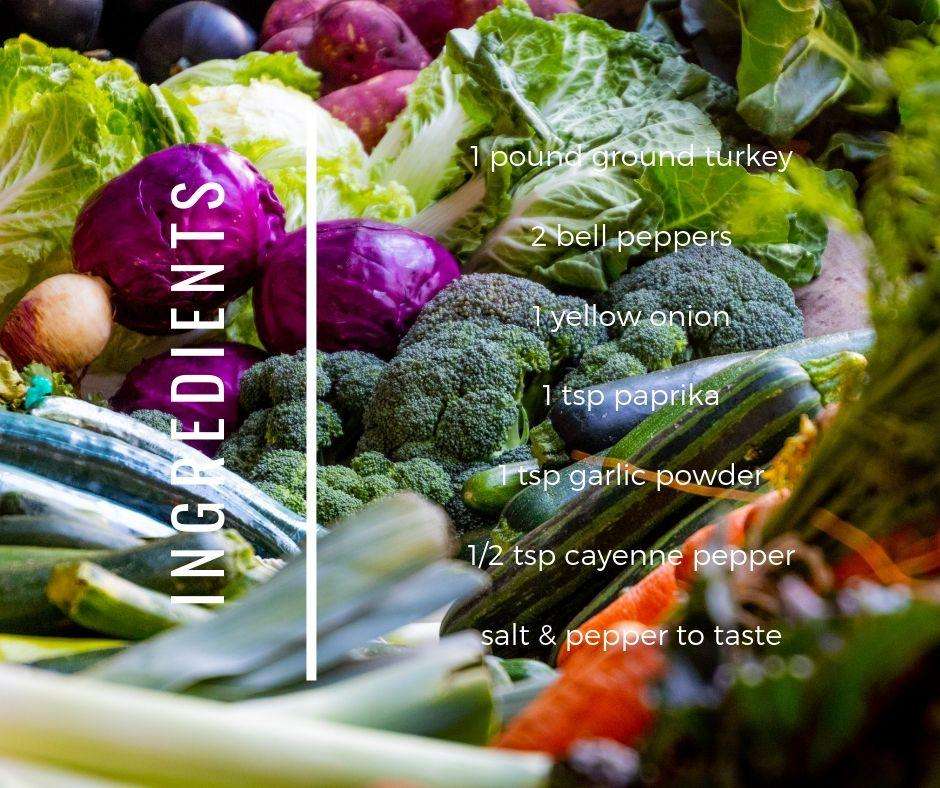
It’s best to cook the ground turkey first. Place the turkey in the skillet and add the garlic powder, paprika, cayenne pepper, and salt and pepper. Mix the seasoning into the turkey and cook it over medium high heat. Make sure the turkey is cooked through, dump it in a bowl and set it aside. In the photos the yellow onion cubed and the peppers are sliced into small strips. Place the vegetables into the skillet that you cooked the turkey in- the juices from the turkey add flavor to the vegetables without having to season them! Cook the vegetables until soft and remove from the heat.
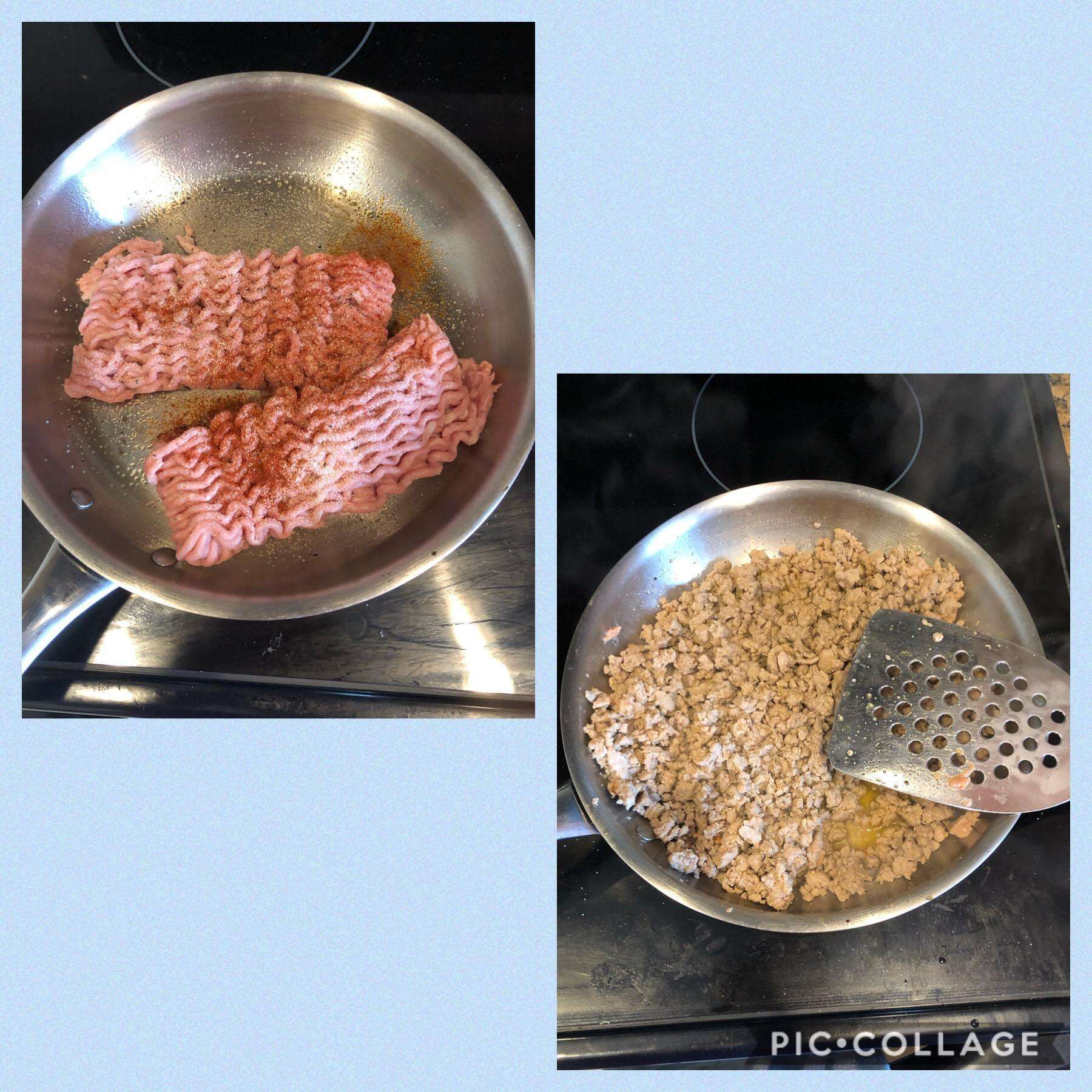
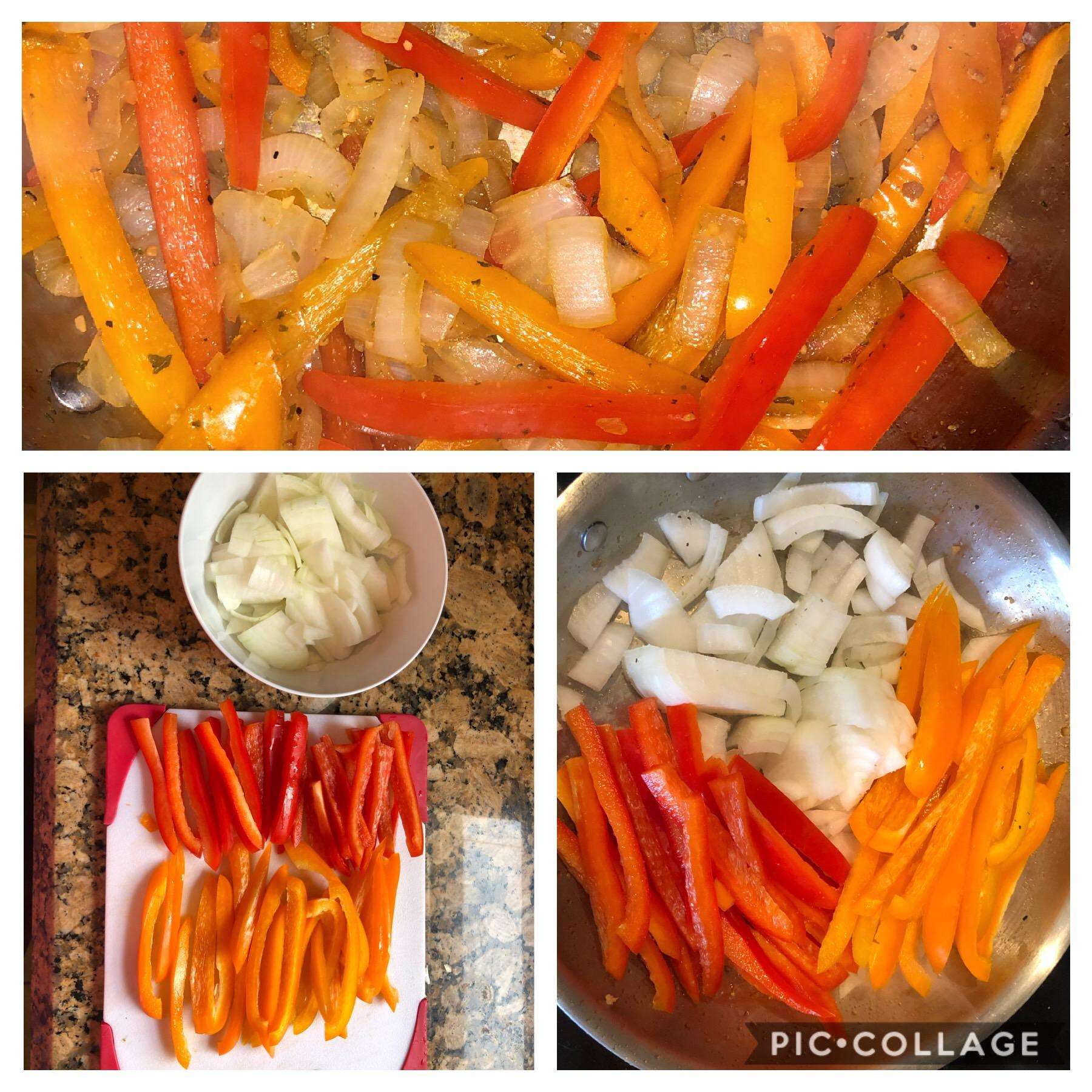
Next, portion out the vegetables into three containers. One cup of bell peppers weights about 6.2 ounces. After the vegetables have been placed in the storage containers-weight out your protein. I typically weigh out 4 oz of protein for each meal. This gives exactly three servings of 4 ounces of ground turkey. Place the turkey over the vegetables and allow to cool before putting the lid on and storing. This minimizes condensation build up.
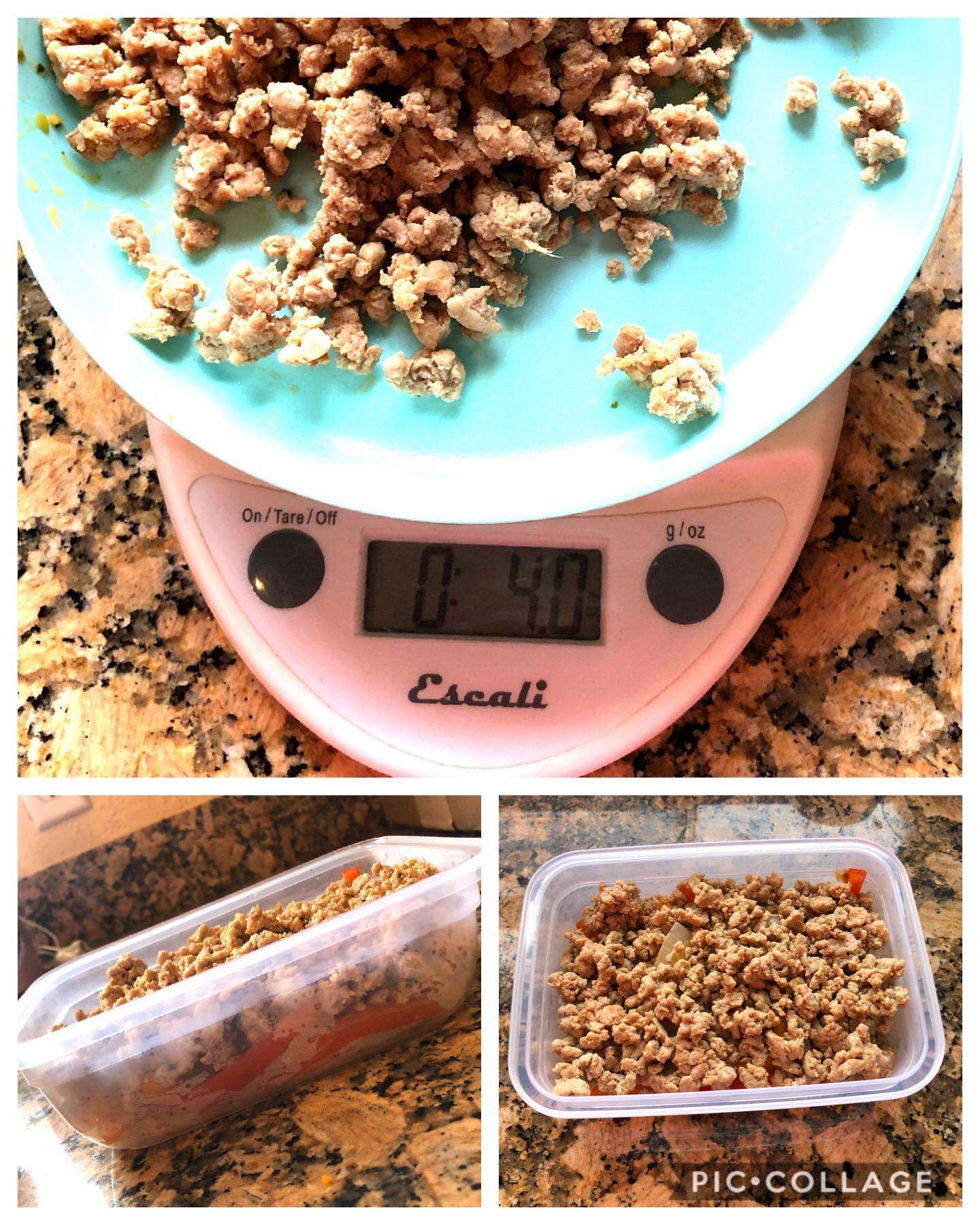
This whole process usually takes about 25 minutes and it is super easy. I found it best to set aside one day a week for meal preparation. It’s easier this way if you live a busy lifestyle and it takes up minimal time. The vegetables can be purchased pre-cut making this process quicker and easier as well. You can also hot sauce to it when eating it to add more flavor! This recipe leaves a lot of room to change for taste-the flavor profile can be changed as well to make it very functional in every meal preparation! Enjoy!
Superfoods. This term is defined as “a food (such as salmon, broccoli, or blueberries) that is rich in compounds (such as antioxidants, fiber, or fatty acids) considered to be beneficial to a person’s health.”
There is no scientifically based or regulated definition for superfoods. This term is used as more of a reference to foods that offer high levels of desirable nutrients that are linked to prevention of a disease or is believed to offer several simultaneous health benefits beyond its nutritional value. There is a lot more research going into the benefits of different foods that could qualify as superfood status. We will be introducing some superfoods that are beneficial to overall health. It is important to remember throughout this article that while these foods may have health benefits – they can be harmful if over consumed and without a lack of variety in the diet. It is important to maintain a wide variety of food to ensure that you are consuming a wide variety of vitamins and minerals and not too much of a particular nutrient.
Some superfoods that might be worthy of this title are dark green leafy vegetables. These vegetables include spinach, kale, swiss chard, and turnip greens. They provide folate, zinc, calcium, iron, magnesium, vitamin C, and fiber. They also have potential to reduce your risk of chronic illnesses such as heart disease and type 2 diabetes. They contain high levels of anti-inflammatory compounds called carotenoids. Carotenoids may help protect against certain types of cancer.
Another type of superfood is berries. They are a powerhouse of vitamins, minerals, fiber, and antioxidants. Berries strong antioxidant levels help reduce the risk and fight chronic diseases and inflammation. Berries also have been recorded as effective when treating digestive and immune-related disorders with medical therapies. Some berries to incorporate into your diet include raspberries, strawberries, blueberries, and blackberries.
Eggs, even though they are high in cholesterol, they are one of the healthiest foods. They are highly rich in nutrients such as B vitamins, choline, selenium, vitamin A, iron, and phosphorus. They are loaded with protein and increase “good” HDL cholesterol in some people. Eggs contain two strong antioxidants;zeaxanthin and lutein. These antioxidants are known to protect vision and eye health.
Nuts and seeds are a great source of fiber, heart-healthy fats, and protein. They have plant compounds that have anti-inflammatory and antioxidant properties. These compounds can help protect against oxidative stress and heat disease. Some sources of these nutrients are almonds, pistachios, sunflower seeds, pumpkin seeds, and walnuts.
Garlic is a strong superfood. It’s a great source of manganese, vitamin C, vitamin B6, selenium, and fiber. It has been used for centuries for its medicinal benefit. Research has indicated that it can be effective in reducing blood pressure, cholesterol, preventing certain types of cancer, and supporting immune function. It has antimicrobial and antifungal properties as well from the components found inside of it.
Ginger, which is available fresh, as an oil, in juice, or in dried and powdered forms, contains large amounts of antioxidants. It may be effective for fighting nausea and reducing acute and chronic inflammation. It may also reduce your risk of chronic illnesses. A close relative of ginger is Turmeric. It also has potent antioxidant and anti-inflammatory effects. Curcumin is the compound that is thought to have these effects in turmeric. It may be effective in treating chronic diseases and aiding in wound healing and pain reduction.
Salmon is known to be high in healthy fats, proteins, B vitamins, potassium and selenium. It is one of the best sources of omega-3 fatty acids. These fatty acids aid in reducing inflammation. Eating salmon is healthy in moderation because like other types of seafood there is a possibility that they contain heavy metals and other environmental pollutants. Salmon may also lower your risk of heart disease and diabetes.
Avocados are highly nutritious and rich in many nutrients. They have fiber, vitamins, minerals, and healthy fats. It is high in monounsaturated fats (MUFAs) with the most predominant MUFA being oleic acid. Oleic acid is linked to reducing inflammation in the body. Avocados may reduce your risk of heart disease, diabetes, metabolic syndrome, and certain types of cancer.
Mushrooms, there are so many types of edible mushrooms and their nutrient content varies depending on the type. Mushrooms contain vitamin A, potassium, fiber, and several antioxidants. They may play a role in reducing inflammation and preventing certain types of cancers based on their antioxidant content.
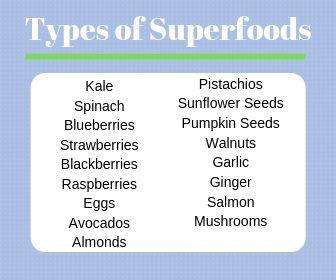
These are only SOME beneficial superfoods there are many more. Overall it is important to incorporate these foods in a diverse diet. Try not to focus on eating just one type of food in order to avoid consuming too much of one nutrient and not enough of others. Including some or all of these foods as part of a balanced diet can benefit your overall health.
7301 West Palmetto Road, Suite 103A
Boca Raton, FL 33433
820 Lafayette St
Cape Coral, FL 33904
5561 N University Drive, Suite 104
Coral Springs, FL 33067
13450 Parker Commons Blvd, Suite 105
Fort Myers, FL 33912
719 Rodel Cove, Suite 1031
Lake Mary, FL 32746
8095 Spyglass Hill Road, Unit 105
Melbourne, FL 32940
5495 Bryson Drive, Suite 413
Naples, FL 34109
899 Outer Road, Suite A
Orlando, FL 32814
100 Madrid Blvd,
Suite 313
Punta Gorda, FL 33950
3202 Henderson Blvd, Suite 104
Tampa, FL 33609
Why wait for your consultation with our weight loss doctors and nutrition coaches? It's free!